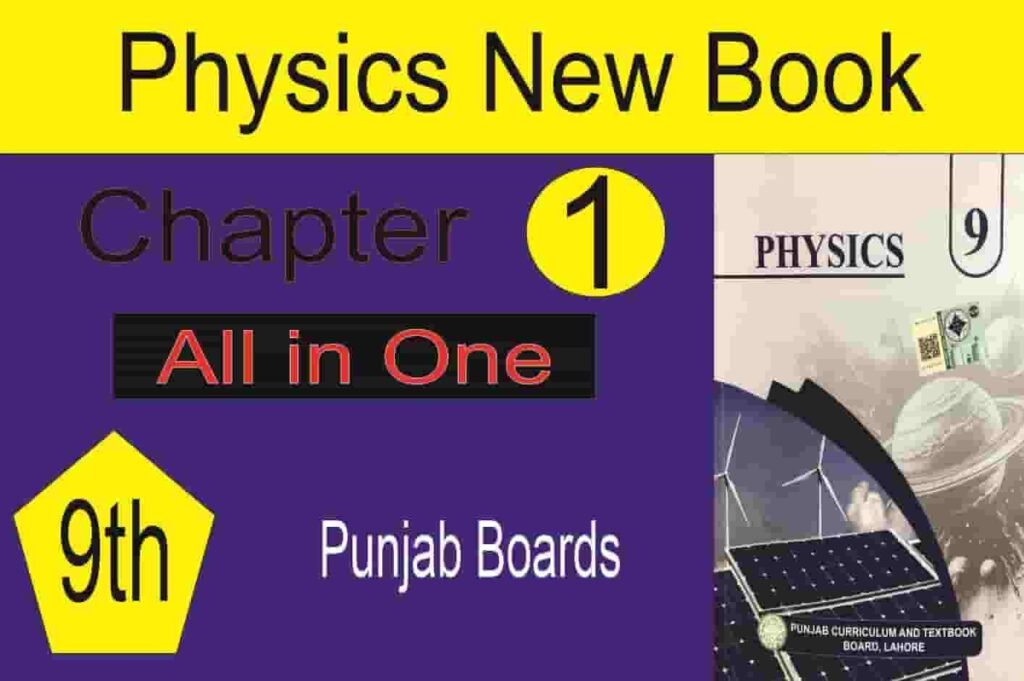9th Physics New Book Chapter 1
9th Physics New Book Chapter 1 MCQs, Short question answers, Long question answers and Numerical will also be solved. Punjab text book board published 9th physics new book.
Physics 9th Chapter 1 MCQs
Tick the correct answer.
1.1 The instrument that is most suitable for measuring the thickness of a few sheets of cardboard is
(a) meter rule (b) Measuring tape (c) Vernier Callipers (d) micermeter screw gauge
Option C is correct.
Reason:- Vernier callipers precisely measures the thickness of cardboard sheets due to its flat jaw.
————————————————————————-
1.2 One femtometer is equal to
$$(a)\;10^{-9}m\;(b)\;10^{-15}m\;(c)\;10^9m\;(d)\;10^{15}m$$
Option B is correct.
Reason:- Femto means 10 to raised power -15. In Nuclear physics, we use this unit.
————————————————————————-
1.3 A light year is a unit of
(a) light (b) time (c) distance (d) speed
Option C is correct.
Reason:- Light year is a distance that light travels in 1 year in vacuum. In Astronomy, we use this unit.
$$Speed\;of\;light\;is\\3\;\times\;10^8\;m\;s^{-1}\;$$
————————————————————————-
1.4 Which one is a non-physical quantity ?
(a) distance (b) density (c) colour (d) temperature
Option C is correct.
Reason:-Colour depends on observer.
————————————————————————-
1.5 When using a measuring cylinder, one precaution to take is to:
(a) check for the zero error (b) look at the meniscus from below the level of the water surface (c) take several readings by looking from more than one direction (d) position the eye in line with bottom of the meniscus
Option D is correct.
Reason:- Correct position of eye will almost eliminate the chances of human error.
————————————————————————-
1.6 Volume of water consumed by you per day is estimated in:
(a) millilitre (b) litre (c) kilogram (d) cubic meter
Option B is correct.
Reason:- Litre its a convenient unit for everyday life.
————————————————————————-
1.7 A displacement can is used to measure:
(a) mass of a liquid (b) mass of a solid (c) volume of a liquid (d) volume of a solid
Option D is correct.
Reason:- Displacement can can measure volume of regular as well as irregular shaped solid by displacement method.
We can directly measure mass of liquid and solid with the help of balance and measuring cylinder can measure the volume of a liquid.
————————————————————————-
1.8 Two rods with lengths 12.321 cm and10.3 cm are placed side by side, the difference of their lengths is:
(a) 2.02 cm (b) 2.0 cm (c) 2 cm (d) 2.021 cm
Option B is correct.
Reason:- There are 5 significant figures in 12.321 and 3 significant figures in 10.3. So we will use only 3 first significant figures in 12.321. Hence, 12.3 – 10.3 = 2.0
We can also say that 12.321 is accurate to 3 decimal places and 10.3 is accurate to 1 decimal place. So, final answer must be round of to 1 decimal place. Hence 12.321-10.3 = 2.021 is raw subtraction and when we round of 2.021 up to 1 decimal place, we will get 2.0
————————————————————————-
1.9 Four students measure the diameter of a cylinder with vernier callipers. which of the following reading is correct ?
(a) 3.4 cm (b) 3.475 cm (c) 3.47 cm (d) 3.5 cm
Option C is correct.
Reason:- Least count of vernier calliper is 0.01 cm which is 2 decimal places and there are also 2 digits after the decimal in 3.47.
————————————————————————-
1.10 Which of the following measures are likely to present the thickness of a sheet of this book ?
$$(a)\;\;6\times10^{-25}\;m\;\;\;(b)\;1\times10^{-4}\;m\\\\(c)\;1.2\times10^{-15}\;m\;\;(d)\;4\times10^{-2}\;m$$
Option B is correct.
Reason:- Measurements in option a and c are very small and measurement in option d is 4 cm. Option B is 0.1 mm so, its correct.
————————————————————————-
1.11 In a vernier callipers ten smallest divisions of the vernier scale are equal to nine smallest divisions of the main scale. If smallest division of the main scale is half millimetre, the vernier constant is equal to:
(a) 0.5 mm (b) 0.1 mm (c) 0.05 mm (d) 0.001 mm
Option C is correct.
Reason:- 10 vernier scale division is equal to 9 main scale division.
Least count or vernier constant = 1 main scale division – 1 vernier scale division
= 1 mm – 0.9 mm = 0.1 mm
Its given that 10 VSD = 9 MSD and 1MSD = Half millimetre
So, 10 VSD = 9 ( o.5 mm ) = 4.5 mm
Hence 1VSD = 4.5/10 = 0.45 mm
vernier constant = 1 main scale division – 1 vernier scale division
VC = 0.5 mm – 0.45 mm = 0.05 mm
————————————————————————-
————————————————————————-
9th Physics Chapter 1 Short questions
————————————————————————-
Q 1.1 Can a non-physical quantity be measured ? If yes, then how ?
No. With thw help of using tools and instruments, we cannot measure a non-physical quantity because it does not have a defined physical unit. Love, beauty, honesty and trust are non-physical quantities.
————————————————————————-
Q 1.2 What is measurement ? Name its two parts
Measurement is a process of comparison of an unknown quantity with a standard quantity (unit).
Measurement consists of two parts, a number (magnitude or numerical value) and a unit. In 5 meters, 5 is magnitude and meter is unit.
————————————————————————-
Q 1.3 Why do we need a standard unit for measurement ?
Standard unit for measurement can be for efficient working and growth of trade, business and share scientific information.
————————————————————————-
Q 1.4 Write the name of 3 base quantities and 3 derived quantities.
Base quantities are length, mass and time.
Derived quantities are area, volume and speed.
————————————————————————-
Q 1.5 Which SI unit will you use to express the height of you desk ?
To express the height we will use meter.
————————————————————————-
Q 1.6 Write the name and symbols of all SI base units.
| Name of Unit | Symbol of Unit |
|---|---|
| Meter | m |
| Kilogram | kg |
| Second | s |
| Kelvin | K |
| Ampere | A |
| Candela | cd |
| Mole | mol |
Q 1.7 Why prefix is used ? Name three sub-multiples and three multiple prefixes with their symbols.
We use prefix to make unit simple and easy. Three sub-multiples are deci, centi and milli denoted by d, c and m respectively.
Three multiples are kilo, mega and giga denoted by k, M and G respectively.
————————————————————————-
Q 1.8 What is meant by:
$$(a)\;5\;pm\;\;(b)\;15\;ns\\(c)\;6\;\mu m\;\;(d)\;\;5\;fs$$
$$5\;pm\;means\;\;5\;pico\;meters\\15\;ns\;means\;15\;nano\;seconds\\6\;\mu m\;means\;\;6\;micro\;meter\;\;\\5\;fs\;means\;\;5\;femto\;seconds$$
Q 1.9 (a) For what purpose, a vernier callipers is used ?
(b) Name its two pain parts.
(c) What is meant by zero error
A vernier callipers measures small lengths with high precision.
There are two main parts of vernier callipers, main scale and vernier scale.
If the zero of the main scale and zero of the vernier scale do not exactly coincide with each other, then there is a zero error in that vernier calliper.
————————————————————————-
Q 1.10 State least count and vernier scale reading as shown in the figure and hence, find the length.
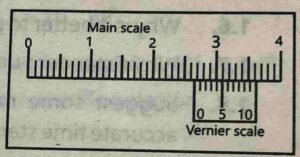
Least count of vernier callipers is 0.01 cm.
$$\style{font-size:12px}{Length\;of\;object\;is\;equal\;to\;\\Main\;scale\;reading+\\(least\;count\times Vernier\;scale\;reading)}$$
Length = 2.6 + (0.01) (4) = 2.6 + 0.04 = 2.64 cm
Q 1.11 Which reading out of A, B and C shows the correct length and why ?
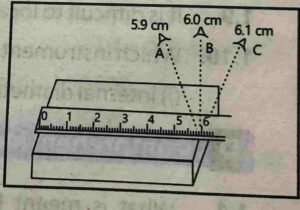
B is correct because the eye is in line with the mark and perpendicular to the scale.
————————————————————————-
9th Physics Chapter 1 Long Questions
————————————————————————-
Q 1.1 What is meant by base and derived quantities ? Give the names and symbols of SI base units.
The quantities which are independent of the other physical quantities are called base quantities. We cannot define any base quantity in terms of any other quantity.
Derived quantities are the quantities which can be defined with reference to base quantities.
There are seven base physical quantities and hence seven base units. Symbol of meter is m, kilogram is kg, second is s, kelvin is K, ampere is A, candela is cd and mole is mol.
| Name of Unit | Symbol of Unit |
|---|---|
| Meter | m |
| Kilogram | kg |
| Second | s |
| Kelvin | K |
| Ampere | A |
| Candela | cd |
| Mole | mol |
Q 1.2 Give three examples of derived units in SI. How are they derived from base units ? Describe briefly.
Some of the derived physical quantities are area, volume and speed and there units are square meter, cubic meter and meter per second respectively.
When we multiply or divide two or more than two base units, we get derived units. Remember that by adding or subtracting base units, we cannot get a derived unit.
$$Area\;=\;Length\;\times\;breath\\=\;meter\;\times\;meter\\=\;Square\;meter\;=\;m^2$$
$$Volume=Length\times breath\times height\\=\;meter\;\times\;meter\;\times\;meter\\=\;Cubic\;meter\;=\;m^3$$
$$Speed\;=\;\frac{dis\tan ce}{time}\\=\frac{meter}{second}=\;m\;s^{-1}$$
Q 1.3 State similarities and differences between Vernier Callipers and micrometer screw gauge.
Similarities between Vernier Callipers and micrometer screw gauge:
Similarities
Vernier callipers and micrometer screw gauge both are measurement instruments and are also more accurate than meter rod.
They both have a main scale and a secondary scale and also measure in milli meters. Usually, we use metals to make them.
Differences
Least count of Vernier callipers is 0.1 mm and least count of screw gauge is 0.01 mm.
Design of vernier callipers and screw gauge is totally different with each other.
Vernier callipers has jaws but screw gauge has spindle.
Screw gauge measures only external dimensions where as Vernier callipers measures external as well as internal dimensions.
Q 1.4 Identify and explain the reasons for human errors, random errors and systematic errors in experiments.
There are three types of experimental errors. Human errors, systematic errors and random errors.
Identifications of errors
Human error
We can easily identify human error by checking the readings of results.
For example there is a huge difference between 5 cm and 0.5 cm.
Systematic error
We can identify systematic error by carefully checking the equipment.
For example zero error in vernier callipers is a systematic error.
Random error
We can identify a random error when every time our measurements are slightly different with each other.
For example if we measure a pen three times and get 11 cm, 11.1 cm and 11.2 cm.
Reasons for errors
Human error
Human errors occur due to personal performance.They can also happen due to recording wrong value during the experiment and poor timing.
Systematic error
Systematic error occurs because of zero error of instrument, poor calibration of instrument or incorrect marking. It can also happen due to consistent mistakes in the experimental setup.
Random error
Random error usually occurs due to sudden change in the environmental conditions and measuring instrument. It can also happen due to different actions of a man, who is performing the experiment.
Q 1.5 Differentiate between precision and accuracy of a measurement with examples.
Precision
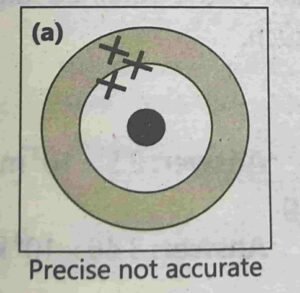
Precision of measurement means the measurements that are very close to each other.
It is determined by the instrument. The smaller the least count, the more precise is the measurement.
The measurements 99.9, 100.1 and 100.2 are precise measurements though the true measurement is 90.
Accuracy

Accuracy of a measurement refers how close the measured value is to accepted or true value.
Significant figures tell us about accuracy. The larger the number of significant figures, the higher is the accuracy.
The measurements 98,101 and 102 are accurate measurements if true value is 100.
The measurement 99.9, 100.1 and 100.2 are precise as well as accurate measurements if true value is 100.
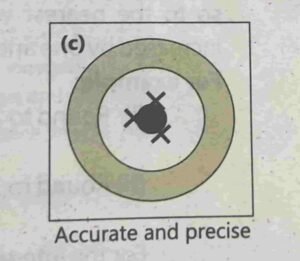
————————————————————————-
class 9 physics chapter 1 Numerical
————————————————————————-
1.1 Calculate the number of seconds in a (a) day (b) week (c) month and state you answer using SI Prefixes.
Number of minutes in 1 hour = 60 Seconds in 1 hour = (60) (60) = 3600
Seconds in 1 day = (3600) (24) = 86,400
$$=(\frac{86400}{1000})\;(1000)s\\\\=(86.4)\;(1000)s\\\\=86.4\;Ks\\$$
Number of seconds in a week = (86,400) (7) = 604,800
$$=(\frac{604800}{1000})\;(1000)s\\\\=(604.8)\;(1000)s\\\\=604.8\;Ks\\$$
Number of seconds in 1 month = (86,400)(30) = 2,592,000
$$=(\frac{2592000}{1000000})\;(1000000)s\\\\=(2.592)\;(1000000)s\\\\=2.592\;Ms\\$$
————————————————————————-
1.2 State the answers of problem 1.1 in scientific notation
Number of minutes in 1 hour = 60
seconds in 1 hour = (60) (60) = 3600
Its mean seconds in 1 day = (3600) (24) = 86,400 = $$8.64\;\times\;10^4$$
seconds in a week = (86,400) (7) = 604,800 = $$6.048\;\times\;10^5$$
seconds in 1 month = (86,400)(30) = 2,592,000 = $$2.592\;\times\;10^6$$
————————————————————————-
1.3 Solve the following addition or subtraction. State your answer in scientific notation
$$(a)\;\;4\times10^{-4}kg\;+3\times10^{-5}kg\\\\=\;10^{-4}(4\;+\;3\times10^{-1}\;)\;kg\\\\=\;10^{-4}(4\;+\;\frac3{10}\;)\;kg\\\\=\;10^{-4}(4\;+\;0.3)\;kg\\\\=\;10^{-4}(4.3\;)\;kg\\\\=\;4.3\;\times10^{-4}\;kg\\\\\\(b)\;\;5.4\times10^{-6}\;m\;-\;3.2\times10^{-5}\;m\\\\=\;10^{-5}(5.4\;\times10^{-1}-3.2)m\\\\=\;10^{-5}(\frac{5.4}{10}-3.2)m\\\\=\;10^{-5}(0.54-3.2)m\\\\=\;10^{-5}(-2.66)m\\\\=\;-2.66\;\times10^{-5}m\\\\\\\\\\$$
————————————————————————-
1.4 Solve the following multiplication or division. State your answer in scientific notation.
$$(a)\;\;\;(5\times10^4m)\;\times\;(3\times10^{-2}m)\\(b)\;\;\;\frac{6\times10^8kg}{3\times10^4\;m^3}\;\\$$
$$(a)\;\;\;(5\times10^4m)\;\times\;(3\times10^{-2}m)\\\\=\;\;5\times3\times10^4\times10^{-2}\times m\times m\\\\=\;15\times10^{4-2}\;\times m^2\\\\=\;15\times10^2\;m^2\\\\=\;1.5\;\times10^1\;\times10^2\;m^2\\\\=\;1.5\;\times10^{1+2}m^2\\\\=\;1.5\;\times10^3m^2\\\\\\(b)\;\;\;\frac{6\times10^8kg}{3\times10^4\;m^3}\;\\=\;2\times10^8\times10^{-4}\;kg\;m^{-3}\\\\=\;2\times{(10)}^{8-4}\;kg\;m^{-3}\\\\=\;2\times10^4\;kg\;m^{-3}\\\\$$
————————————————————————-
1.5 Calculate the following. State your answer in scientific notation.
$$\frac{(3\times10^2kg)\times(4.0km)}{5\times10^2\;s^2}\\\\\frac{12}5kg\;km\;s^{-2}\\\\2.4\;kg\;km\;s^{-2}\\\\2.4\;\times\;1000\;kg\;m\;s^{-2}\\\\2.4\;\times10^3\;kg\;m\;s^{-2}\\\\$$
————————————————————————-
1.6 State the number of significant digits in each measurement.
$$(a)\;0.0045m\;\;(b)\;2.047m\;\;(c)\;3.40m\;\;(d)\;3.420\;\times\;10^4m\\\\\boldsymbol(\boldsymbol a\boldsymbol)\boldsymbol\;\mathbf0\boldsymbol.\mathbf{0045}\boldsymbol m\\\\All\mathit\;non\mathit\;zero\mathit\;digits\mathit\;are\mathit\;significant\mathit.\\\\Zeros\;are\;not\;significant\;here.\;4\;and\;5\;are\;significant.\\\\Hence,\;there\;are\;only\;2\;significant\;figures.\\\\\\\boldsymbol(\boldsymbol b\boldsymbol)\boldsymbol\;\mathbf2\boldsymbol.\mathbf{047}\boldsymbol m\\\\All\mathit\;non\mathit\;zero\mathit\;digits\mathit\;are\mathit\;significant\mathit.\;\\\\Zero\;between\;non\;zeros\;are\;significant.\;\\\\All\;the\;digits\;are\;significant\;here.\\\\Hence,\;there\;are\;4\;significant\;figures.\\\\\\\boldsymbol c\boldsymbol)\boldsymbol\;\mathbf3\boldsymbol.\mathbf{40}\boldsymbol m\\\\All\mathit\;non\mathit\;zero\mathit\;digits\mathit\;are\mathit\;significant\mathit.\\\\Zero\;after\;the\;decimical\;point\;is\;significant.\\\\Hence,\;there\;are\;3\;significant\;figures.\\\\\\\boldsymbol(\boldsymbol d\boldsymbol)\boldsymbol\;\mathbf3\boldsymbol.\mathbf{420}\boldsymbol\;\boldsymbol\times\boldsymbol\;\mathbf{10}^{\mathbf4}\boldsymbol m\\\\All\mathit\;non\mathit\;zero\mathit\;digits\mathit\;are\mathit\;significant\mathit.\\\\Zero\;after\;the\;decimical\;point\;is\;significant.\\\\Hence,\;there\;are\;4\;significant\;figures.\\\\\\\\\\$$
————————————————————————-
1.7 Write in scientific notation
$$(a)\;\;0.0035m\\\\=\;3.5\;\times\;10^{-3}\;m\\\\\\(b)\;\;206.4\;\times10^2\;m\\\\=\;2.064\;\times\;10^2\;\times\;10^2\;m\\\\=\;2.064\;\times\;10^{2+2}\;m\\\\=\;2.064\;\times\;10^4\;m\\\\$$
————————————————————————-
1.8 Write using correct prefixes
$$\boldsymbol(\boldsymbol a\boldsymbol)\boldsymbol\;\boldsymbol\;\mathbf5\boldsymbol.\mathbf0\boldsymbol\;\boldsymbol\times\boldsymbol\;\mathbf{10}^{\mathbf4}\boldsymbol\;\boldsymbol c\boldsymbol m\\\\=\;5.0\;\times\;10^4\;\times\;10^{-2}m\\\\=\;5.0\;\times\;10^{4-2}m\\\\=5.0\;\times\;10^2m\\\\=\;\frac{5.0\;\times\;10^2km}{1000}\\\\=\;\frac{5.0\;\times\;100\;km}{1000}\\\\=\;\frac{500\;km}{1000}\\\\=\;0.5\;km\\\\\boldsymbol(\boldsymbol b\boldsymbol)\boldsymbol\;\boldsymbol\;\mathbf{580}\boldsymbol\;\boldsymbol\times\boldsymbol\;\mathbf{10}^{\mathbf2}\boldsymbol\;\boldsymbol g\\\\=\frac{\;580\;\times\;10^2\;kg}{1000}\\\\=\;\frac{\;580\;\times\;100\;kg}{1000}\\\\=\;58\;kg\\\\\boldsymbol(\boldsymbol c\boldsymbol)\boldsymbol\;\boldsymbol\;\mathbf{45}\boldsymbol\;\boldsymbol\times\boldsymbol\;\mathbf{10}^{\boldsymbol-\mathbf4}\boldsymbol\;\boldsymbol s\\\\=\;45\;\times\;10^{-4}\;\times\;1000\;\;ms\\\\=\;\frac{45\;\;\times\;1000\;\;ms}{10^4}\\\\=\;\frac{\;45000\;\;ms}{10000}\\\\=\;4.5\;ms\\\\$$
————————————————————————-
1.9
$$Light\;year\;is\;a\;unit\;of\;dis\tan ce\\used\;in\;Astronomy.\;It\;is\;the\\dis\tan ce\;covered\;by\;light\;in\\one\;year.\;Taking\;tha\;speed\\of\;light\;as\;3.0\;\times10^8\;m\;s^{-1},\\calculate\;the\;dis\tan ce\\\\\\$$
$$Number\;of\;seconds\;in\;\boldsymbol o\boldsymbol n\boldsymbol e\boldsymbol\;\boldsymbol m\boldsymbol i\boldsymbol n\boldsymbol u\boldsymbol t\boldsymbol e\;=\;60\\\\Number\;of\;seconds\;in\;\boldsymbol o\boldsymbol n\boldsymbol e\boldsymbol\;\boldsymbol h\boldsymbol o\boldsymbol u\boldsymbol r\;=\;60\;\times\;60\\\\Number\;of\;seconds\;in\;\boldsymbol o\boldsymbol n\boldsymbol e\boldsymbol\;\boldsymbol d\boldsymbol a\boldsymbol y\;=\;60\;\times\;60\;\times\;24\\\\number\;of\;seconds\;in\boldsymbol\;\boldsymbol o\boldsymbol n\boldsymbol e\boldsymbol\;\boldsymbol y\boldsymbol e\boldsymbol a\boldsymbol r\boldsymbol\;=\;60\;\times\;60\;\times\;24\;\times\;365\\\\Number\;of\;seconds\;in\boldsymbol\;\boldsymbol o\boldsymbol n\boldsymbol e\boldsymbol\;\boldsymbol y\boldsymbol e\boldsymbol a\boldsymbol r\;=\;31,536,000\\\\\\Dis\tan ce\;=\;31,536,000\;\times\;3.0\;\times\;10^8\;m\\\\Dis\tan ce\;=\;94,608,000\;\times\;10^8\;m\\\\Dis\tan ce\;=\;9.4608\;\times\;10^7\;\times\;10^8\;m\\\\Dis\tan ce\;=\;9.4608\;\times\;10^{7+8}\;m\\\\Dis\tan ce\;=\;9.4608\;\times\;10^{15}\;m\\\\\\$$
————————————————————————-
1.10
$$Express\;the\;density\;of\\mercury\;given\;as\\13.6\;g\;c\;m^{-3}\;in\;kg\;m^{-3}\\\\\\$$
$$13.6\;g\;c\;m^{-3}\\\\=\;\frac{13.6\;\;kg\;c\;m^{-3}}{1000}\\\\=\;0.0136\;\;kg\;c\;m^{-3}\\\\\mathbf1\boldsymbol\;\boldsymbol c\boldsymbol m\boldsymbol\;\boldsymbol=\boldsymbol\;\mathbf{10}^{\boldsymbol-\mathbf2}\boldsymbol\;\boldsymbol m\\\\\mathbf1\boldsymbol\;\boldsymbol c\boldsymbol\;\boldsymbol m^{\mathbf3}\boldsymbol\;\boldsymbol=\boldsymbol\;\mathbf{10}^{\boldsymbol-\mathbf6}\boldsymbol\;\boldsymbol m^{\mathbf3}\\\\\;0.0136\;\;kg\;c\;m^{-3}\\\\=\frac{0.0136\;kg}{\;c\;m^3}\\\\=\;\frac{0.0136\;kg}{\;10^{-6}\;m^3}\\\\=0.0136\;\times10^6\;\;kg\;\;\;m^{-3}\\\\=\;1.36\;\times\;10^{-2\;}\times10^6\;\;kg\;\;\;m^{-3}\\\\=\;1.36\;\times10^{-2+6}\;\;kg\;\;\;m^{-3}\\\\=\;1.36\;\times10^4\;\;kg\;\;\;m^{-3}\\\\$$
————————————————————————-
Check! Some useful links
You tube 9th Physics new book
Chapter 2 Numerical 9th physics new book
Page 9th physics new book
Home page Notespunjab.com


